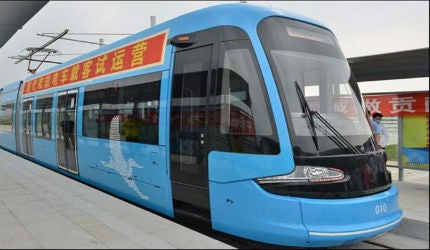
Shenyang tramway system was opened for public in August 2013 during the 12th China National Games. The 70km-long tram line covers 65 stations and handles 150,000 passengers per day.
It is expected to serve about 7.2million residents of the Shenyang city, capital of Liaoning Province. The Shenyang Metro project is also under construction in China.
The construction of China’s first modern tramway was started in February 2012. The tram network is 51% owned by Shenyang’s city government, while the remaining 49% is owned by VTRA, a joint venture of Transdev and RATP Dev.
The VTRA team was selected to operate and maintain the tramway network for the next three years under a CNY330m ($53m) contract signed in April 2013.
The team operates 30 trams, and manages two garage and maintenance depots.
Transdev is a subsidiary of Caisse des Dépôts and Veolia Environnement. RATP Dev is a subsidiary of the RATP Group.
The Transdev-RATP Dev joint venture also operates Hong Kong tramways and the Nanjing urban network.
Shenyang Tramway line routes
The Shenyang Tramway system consists of four lines. The Lines 1, 2 and 5 became operational in August 2013.
Line 1 is 18.7km long running from the Exhibition Center station to the Olympic Center station. The 15km long Line 2 connects the Olympic Center to the Taoxian Airport station. The 15.1km long Line 3 is in testing phase.
Line 5 serves between the Olympic Center station and Shenfu City covering 21.1km length.
Details of the Shenyang trams
The Shenyang trams are nicknamed as dolphin trams because of their dolphin-shaped body design and blue colour. They are designed for a speed of 80km/h.
The trams feature two roof-mounted air-conditioning units and under floor heating coils to keep warm temperature inside. A super capacitor is installed to prevent staggering of electric wires over a way crossing.
The trams feature five cars each, with four door sets, 350mm high floors and a minimum curve radius of 19m. Each tram, with 65 seats and number of wheelchair spaces, accommodates 300 passengers.
Each tram features two Voith DI1000-5AR traction inverters, four Supercap energy storage units and four traction motors. The energy storage units increase the energy efficiency, while the Supercap energy storage units enable catenary-free operation.
Shenyang Tramway expansion plans
The tram network is planned to be expanded with two future lines, Line 6 and Line 4. The Line 6 is under construction, while Line 4 is being reviewed.
Contractors involved with the Shenyang tram project
Voith Turbo, a division of Voith, supplied 50 electric drive systems for the trams under a contract awarded in September 2012.
The electric drive systems increase the maximum power input capacity to 700kW.
Buero-staubach provided interior and exterior designs for the trams.
Rolling stock for China’s Shenyang Tramway
The Changchun Railway Vehicles Company, the rolling stock manufacturer that is part of China CNR Corporation, supplied 30 trams for the Shenyang tram network.
CNR Corporation initially provided 20 low-floor trams in December 2011.
The 20 trams were 100% low-floor cars, where as the remaining 10 trams were 70% low-floor cars.
The 100% low-floor trams are 34.4m long and can accommodate 360 passengers. The 70% low-floor trams are 28.8m long, with capacity to accommodate 300 passengers.
Related content
Shenyang Metro, China
The Government of Shenyang is constructing the biggest subway project in Liaoning province, north-east China.
Beijing Olympic Village Rail Link Construction, China
The 2008 Olympic Games led to a huge investment in transport systems throughout China’s capital city Beijing.







